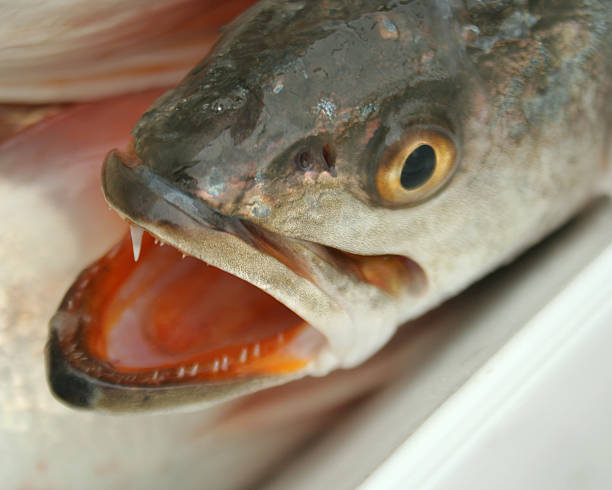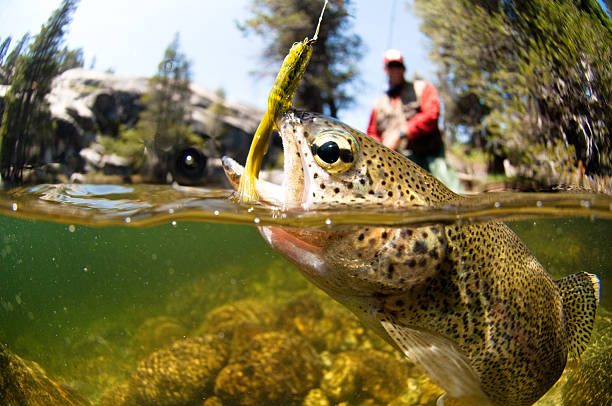Considering how strong and quick they are, trout can be a surprisingly intimidating fish to catch. Trout does have teeth if you’re wondering. The majority of trout species have teeth that, if handled improperly, can cause some damage.
The questions you may have about trout teeth as well as other topics, such as how to hold and handle them and which varieties of trout have different teeth, are all addressed in this article.
Do Trout Have Teeth?
Large trout have powerful jaws and can easily bite aggressively and scavenge blood. Even though smaller trout have teeth, most of them are usually insignificant enough not to cause concern.
The inside roof of the mouth of larger trout is lined with two rows of teeth known as vomerine teeth. A trout uses these teeth to hold and move food down its throat.
Trout and bass are very dissimilar to one another. The lips of the bass have teeth that face inward and are situated there.
If your trout is longer than 16 inches, you might want to remove a fly with hemostats. -Any removal of the lure or baiting of the hook must be done with forceps or a hook remover.
Type of Teeth on a Trout
The middle of the upper jaw is where the vomerine teeth, which are present in the majority of trout species, are located. When trying to eat food in the winter, the fish’s teeth help them grasp and hold onto it.
These teeth are a great indicator of a trout versus a salmon. The specific species of these trout can also be identified using the position of the teeth.
Brown trout, for instance, support their lower tongues with teeth that are situated along the gill and behind the base of the tongue. A salmon may only have one row of teeth, whereas a trout would have two.
These teeth assist in breaking down the food as a trout bites and chews it. The trout’s jaws function like a pair of scissors and aid in slicing through the meat they consume.
While being careful not to swallow any river gravel or debris, the teeth also assist them in filtering their prey out of the water.

Do Rainbow Trout Have Teeth?
Although they have a row of thin teeth in the middle of their upper jaw, the teeth of rainbow trout are not as noticeable because they are located there.
In addition, unlike brown and brook trout, rainbow trout do not open their mouths widely while biting and chewing food.
A small invertebrate can be eaten by rainbow trout thanks to its sharp teeth. To aid them in eating their prey, they have teeth.
A rainbow trout’s mouth should never be held because it has teeth and can bite.
Do Brown Trout Have Teeth?
There are two sets of teeth on brown trout, also known as cutthroat trout.
different from other trout, such as rainbow trout. Both the bottom of their tongue and the length of their Gil are lined with teeth in brown trout.
To aid in the chewing up of any food they consume, cutthroat trout have both sets of teeth in their mouth.
Be extremely careful when handling a large brown trout’s mouth because its teeth can be just as sharp as a pin.
You might need to use a hemostat tool to remove a fly from a fish larger than 15 inches. Your fingers will be safe if you do this.
How to Handle A Trout
It is better for the fish and will increase your chances of success if you net big trout. If squeezed too firmly, this might harm the trout. Try to support the trout instead of squeezing it when handling it.
Please refrain from squeezing if you intend to release. The fish should only be lifted slightly above the water’s surface while still in the net, with the trout facing upstream. The resulting image or video is fantastic.
Some other trout handling tips
• Be quick when lifting from the water. Up, snap, and then down. Take a picture of yourself and give it away.
• The protective mucus on the trout is stripped off by wet hands rather than dry hands or other objects.
• Look over the trout and quickly check to make sure it doesn’t have any sticks, lines, or other debris embedded inside of it.
Final Thought: Be Careful When Fishing
Like much other game fish, trout have teeth on both the lower and upper jaw. The teeth have a jagged appearance, are small, and are angled back toward the throat. Due to their double row of teeth, trout are different from most species. Only a few teeth on the roof of the mouth make up the second row. After catching food between their front teeth, the trout uses their vomerine teeth to help them swallow it.
If you choose to go trout fishing, keep in mind that if you accidentally stick your finger in the fish’s mouth, the teeth could draw blood. Instead, remove the hook by using a pair of needle-nosed fishing pliers. Try to always release the fish you catch into the lake or river after letting it rest in the net. To prevent harming the trout, handle it delicately.

